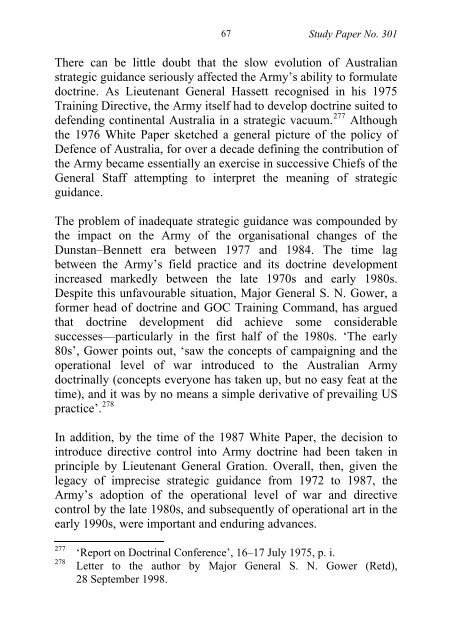Ibid - Australian Army
Ibid - Australian Army
Ibid - Australian Army
You also want an ePaper? Increase the reach of your titles
YUMPU automatically turns print PDFs into web optimized ePapers that Google loves.
67<br />
Study Paper No. 301<br />
There can be little doubt that the slow evolution of <strong>Australian</strong><br />
strategic guidance seriously affected the <strong>Army</strong>’s ability to formulate<br />
doctrine. As Lieutenant General Hassett recognised in his 1975<br />
Training Directive, the <strong>Army</strong> itself had to develop doctrine suited to<br />
defending continental Australia in a strategic vacuum. 277 Although<br />
the 1976 White Paper sketched a general picture of the policy of<br />
Defence of Australia, for over a decade defining the contribution of<br />
the <strong>Army</strong> became essentially an exercise in successive Chiefs of the<br />
General Staff attempting to interpret the meaning of strategic<br />
guidance.<br />
The problem of inadequate strategic guidance was compounded by<br />
the impact on the <strong>Army</strong> of the organisational changes of the<br />
Dunstan–Bennett era between 1977 and 1984. The time lag<br />
between the <strong>Army</strong>’s field practice and its doctrine development<br />
increased markedly between the late 1970s and early 1980s.<br />
Despite this unfavourable situation, Major General S. N. Gower, a<br />
former head of doctrine and GOC Training Command, has argued<br />
that doctrine development did achieve some considerable<br />
successes—particularly in the first half of the 1980s. ‘The early<br />
80s’, Gower points out, ‘saw the concepts of campaigning and the<br />
operational level of war introduced to the <strong>Australian</strong> <strong>Army</strong><br />
doctrinally (concepts everyone has taken up, but no easy feat at the<br />
time), and it was by no means a simple derivative of prevailing US<br />
practice’. 278<br />
In addition, by the time of the 1987 White Paper, the decision to<br />
introduce directive control into <strong>Army</strong> doctrine had been taken in<br />
principle by Lieutenant General Gration. Overall, then, given the<br />
legacy of imprecise strategic guidance from 1972 to 1987, the<br />
<strong>Army</strong>’s adoption of the operational level of war and directive<br />
control by the late 1980s, and subsequently of operational art in the<br />
early 1990s, were important and enduring advances.<br />
277<br />
278<br />
‘Report on Doctrinal Conference’, 16–17 July 1975, p. i.<br />
Letter to the author by Major General S. N. Gower (Retd),<br />
28 September 1998.

















